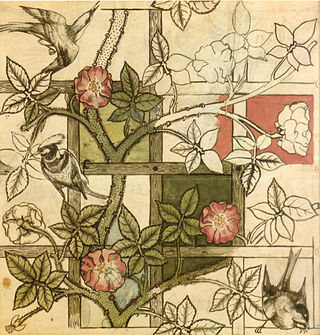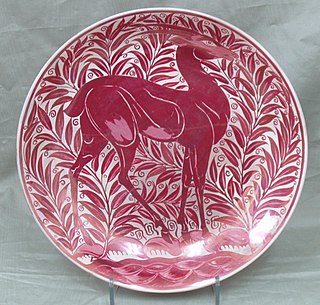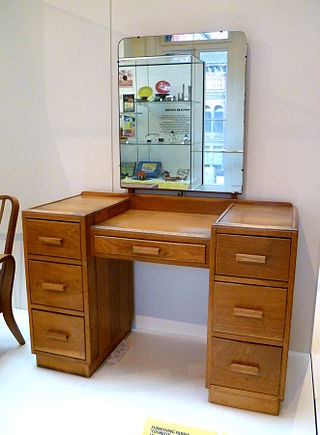
The Arts and Crafts movement was an international trend in the decorative and fine arts that developed earliest and most fully in the British Isles and subsequently spread across the British Empire and to the rest of Europe and America.

A craft or trade is a pastime or an occupation that requires particular skills and knowledge of skilled work. In a historical sense, particularly the Middle Ages and earlier, the term is usually applied to people occupied in small scale production of goods, or their maintenance, for example by tinkers. The traditional term craftsman is nowadays often replaced by artisan and by craftsperson.

Chipping Campden is a market town in the Cotswold district of Gloucestershire, England. It is notable for its terraced High Street, dating from the 14th century to the 17th century.

The Cotswold Way is a 102-mile (164 km) long-distance footpath, running along the Cotswold Edge escarpment of the Cotswold Hills in England. It was officially inaugurated as a National Trail on 24 May 2007 and several new rights of way have been created.
Philip Mairet was a British designer, writer and journalist. He had a wide range of interest: crafts, Alfred Adler and psychiatry, and Social Credit. He translated major figures including Jean-Paul Sartre. He wrote biographies of Sir Patrick Geddes and A. R. Orage, with both of whom he was closely associated, as well as of John Middleton Murry. As editor of the New English Weekly in the 1930s, he championed both Christian socialism, as it was known at the time, and ideas on agriculture that would come together later as organic farming.

Ethel Mary Partridge, Ethel Mary Mairet RDI, or Ethel Mary Coomaraswamy was a British hand loom weaver, significant in the development of the craft during the first half of the twentieth century.

Robert Radford Welch MBE, RDI, was an English designer and silversmith.

Charles Robert Ashbee was an English architect and designer who was a prime mover of the Arts and Crafts movement, which took its craft ethic from the works of John Ruskin and its co-operative structure from the socialism of William Morris.

John Pearson was a master craftsman of the Newlyn School and Guild of Handicrafts. He worked in copper and his style is described as arts and crafts / Modern Style.

Birmingham Guild of Handicraft was an Arts and Crafts organisation operating in Birmingham, England, established at the end of the 19th century.

American Craftsman is an American domestic architectural style, inspired by the Arts and Crafts movement, which included interior design, landscape design, applied arts, and decorative arts, beginning in the last years of the 19th century. Its immediate ancestors in American architecture are the Shingle style, which began the move away from Victorian ornamentation toward simpler forms, and the Prairie style of Frank Lloyd Wright.

Norman Jewson was an English architect-craftsman of the Arts and Crafts movement, who practised in the Cotswolds. He was a distinguished, younger member of the group which had settled in Sapperton, Gloucestershire, a village in rural southwest England, under the influence of Ernest Gimson. Surviving into old age, he brought their ideas and working methods into the second half of the twentieth century. His book of reminiscences has become established as a minor classic of the English Arts and Crafts movement. His repair of the Tudor Owlpen Manor in 1925–26 is often regarded as his most representative and successful work.

Sir Sydney Gordon Russell, was an English designer, craftsman and educationist.

The Modern Style is a style of architecture, art, and design that first emerged in the United Kingdom in the mid-1880s. It was the first Art Nouveau style worldwide, and it represents the evolution of the Arts and Crafts movement which was native to Great Britain. The Modern Style provided the base and intellectual background for the Art Nouveau movement and was adapted by other countries, giving birth to local variants such as Jugendstil and the Vienna Secession. It was cultivated and disseminated through the Liberty department store and The Studio magazine.

Arthur Joseph Gaskin RBSA was an English illustrator, painter, teacher and designer of jewellery and enamelwork.
Peter Waals, born Pieter van der Waals, was a Dutch cabinet maker associated with the Arts and Crafts movement.
Paul Vincent Woodroffe was a British book illustrator and stained-glass artist.

Nelly Erichsen was an English illustrator and painter. Born in Newcastle upon Tyne, she was born into a wealthy professional Danish family. After studies at the Royal Academy of Art in the 1880s, she pursued a successful career as an illustrator and writer, working with a number of publishing firms including J.M. Dent and Macmillan, and jointly publishing travel books with Janet Ross, a prominent member of the Anglo-Tuscan pre-War community. In July 2018 Nelly Erichsen - A Hidden Life, a biography of Erichsen by Sarah Harkness was published.
Frederick James Partridge (c.1877–1946) was an English jeweller, silversmith and teacher of jewellery making, active circa 1901–1930. His works are in the Art Nouveau style. He has been called the "British René Lalique".
Alice Beatrice (Biddy) Waymouth (1884–1963) was a New Zealand metalworker and artist. Her work is held in the collection of the Canterbury Museum, Christchurch.















